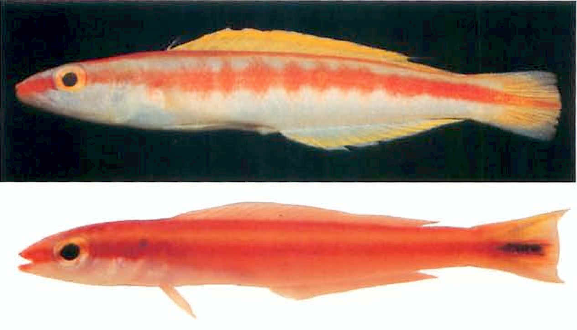Terelabrus is at the moment a monotypic genus first erected in 1998 based on an unknown labrid caught at 100m in Bulari Pass, New Caledonia. Since then, the genus has not expanded despite the appearance of two potentially new species, one of which from the Indian Ocean. In the aquarium trade, these three different looking Terelabrus species have surfaced, of which two are rather uncommon while one is exceedingly rare. It is worthy of mention that there could be a mix up in identity here, and Terelabrus rubrovittatus may be erroneously given to the wrong species in the hobby front.
The picture above are of the original holotype and paratype of T. rubrovittatus. The larger male of 87mm was caught in a trap at 100m in New Caledonia in 1979. It was only 16 years later in 1995 where another specimen was caught, a 32mm juvenile at 92m in Milne Bay. The distinctively different body profile and meristics warranted an erection of a new genus and a new species, Terelabrus rubrovittatus. The generic epithet Terelabrus is an amalgamation of the latin words teres, meaning terete and labrus for wrasse owing to the narrow cylindrical or terete shape of the fish. The specific epithet rubrovittatus means red stripe.

Taking a closer look at Terelabrus rubrovittatus in the holotype photos and in the description papers, you’ll notice the fish, in the adult stage, has a yellow dorsal and anal fin. The body is white with two horizontal red stripes; a narrow one running across the dorsum and one roughly segmented and thicker stripe running laterally just below. The original type and paratype specimens were collected in New Caledonia and Milne Bay PNG, but they have also been found in deepwater Japan, where this individual above was collected.

In this specimen above from Deep Sea Challengers, the fish measured 5 inches from head to tail, and is kept with big boisterous fish like Odontanthias katayamai and Bodianus masudai. This size factor is important when we’re comparing it again later to another similar and wrongly labelled Terelabrus.

A smaller, more common species of Terelabrus has been showing up for a couple of years now from Indonesia. This species is smaller, more slender in appearance and coloured differently. However it has been erroneously given the same name as the preceding species, T. rubrovittatus, and is listed as such in many websites as well as literature. Comparing this to the holotype of T. rubrovittatus, the difference is quite clear. In none of these Indonesian specimens are the unpaired fins yellow. The middle stripe is narrow and even, and the zone between the two red stripes is yellow, a trait unseen in the true T. rubrovittatus. The face also possess blue and yellow squiggles just below the eye in certain usually larger specimens.

Not only is this unknown Terelabrus smaller, more slender and coloured differently, they are also found in generally much shallower waters. In the original T. rubrovittatus, specimens were only seen and collected near 100m depth. The unknown Terelabrus here with the yellow stripe can be found however, at depths as shallow as 20m. Although they can live in much greater depths, they are most often seen and photographed at shallower depths where no true T. rubrovittatus has so far been found.
Like T. rubrovittatus however, this species ranges to Japan as well as many parts of the central pacific where they are often photographed by Japanese divers and photographers. In many of these diving blogs such as Kazkian, they are labelled as Terelabrus sp. Elsewhere however, they have been erroneously identified as T. rubrovittatus for years, especially in the aquarium trade. It is probably due to the scarcity of the real species compared to the relative abundance of this unknown species that led to the confusion. However if you compare the two species you’ll see that the difference in colour, morphology and general preference for depth sets the two species apart easily.

A second species yet to be described and identified has also been offered to the trade regularly, and this species comes out of the Maldives in the Indian Ocean. Like the Terelabrus sp from the pacific, this species is smaller, more slender and coloured differently from T. rubrovittatus. The fish bears the same general pattern, of having a white body with two horizontal red stripes. However in this species, there is no additional yellow stripe in-between the two bands, and the fish is generally much whiter in appearance.
In large specimens the tail may be slightly lanceolated along the central rays. The main distinguishing characteristic for this species with the previous is the lack of yellow and the difference in range. Assuming we are correct, there should now be potentially two additional species of Terelabrus. However the name “Terelabrus rubrovittatus” has been given and used for the wrong species so long now that it might be hard to change. Nevertheless, we hope that in future these two undescribed species get a chance to be properly studied and hopefully that will set things right.
Above is a video of the real Terelabrus rubrovittatus, just as a final look for comparison. Notice how large it is, the coloration as well as the physical form compared to the two other smaller members.



